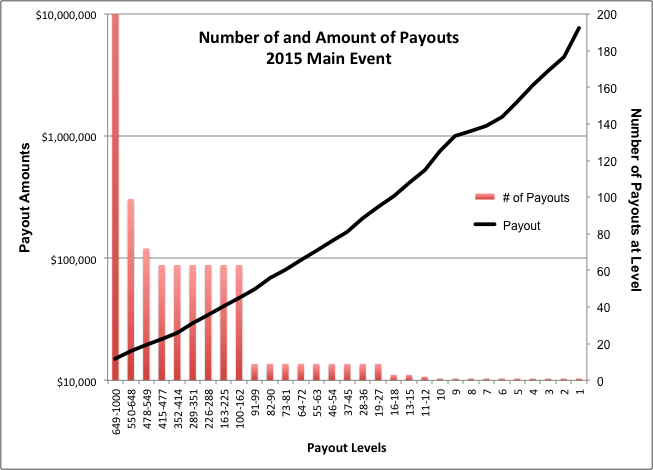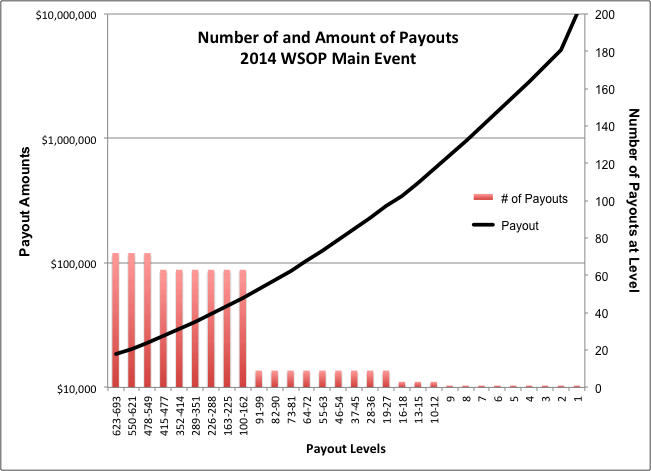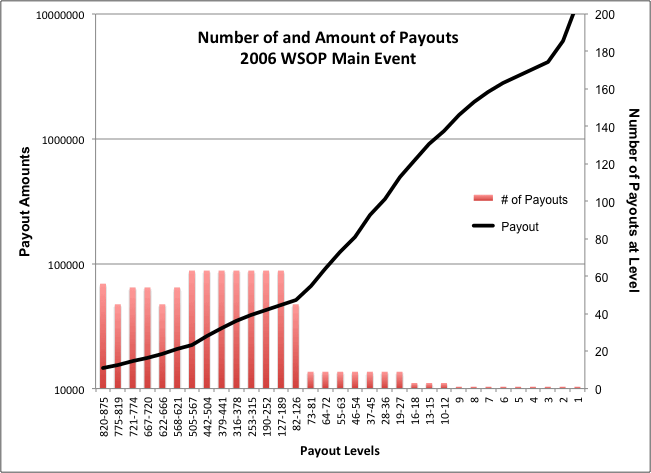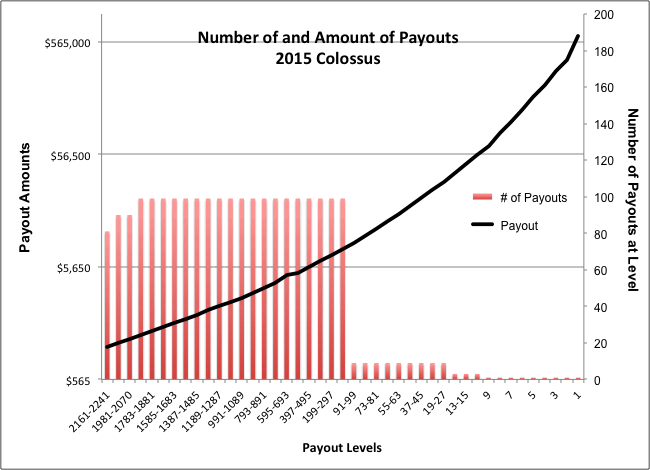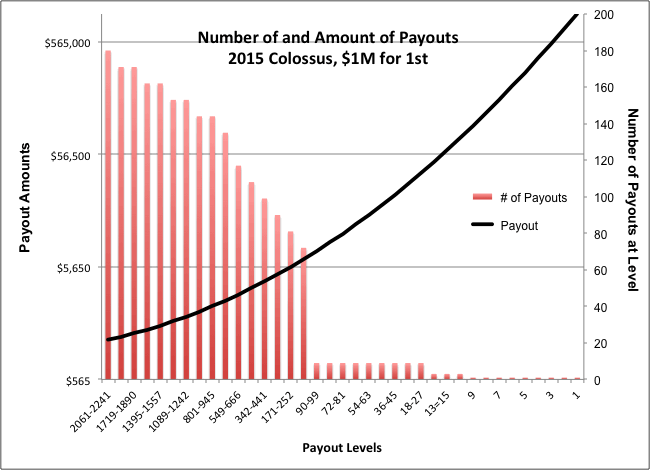“Give me your tired, your poor,
your huddled masses yearning
to win a million dollars,
or at least cash to get 2x their buy-in back….”
—with apologies to Emma Lazarus
Friday’s announcement of dates for the 2016 World Series of Poker—and particularly the details about the sophomore installment of the Colossus tournament—got people buzzing about the upgraded guarantees for both the prize pool and first place, as well as other changes.
There’s a $7M guarantee for the prize pool this year. Last year was $5M, but the actual prize pool was over $11M. Cord Garcia only got $639K last year (less then 6% of the prize pool); this year’s winner—guaranteed $1M—could potentially get as much as 14% (though there’s need to be a significant drop-off of entrants from last year).
A primary complaint about last year’s event—apart from the long payout lines and the general crush of people—was that Garcia got such a small share of the prize pool for coming out on top of more than 22,400 other players. His cash was an ROI of 113,000% (Joe McKeehan’s Main Event cash last month had an ROI over 75,000%) but many people felt it should have been 10% of the prize pool, or at least an even $1M.
Large tournament payout structures are sort of an art. You need to balance the size of each payout step, the number of payouts at each step, and make everything match up to the total in the prize pool. For smaller events, you can use pre-defined tables, but the WSOP uses a formula to determine the payout steps (for the most part, see how the payouts in the Main Event varied over a decade in my article here), the approximation in the rate of increase for each step is something I wrote about for PokerNews.com. The median rate of increase (or acceleration in the size of each step in the payout structure) is about 100.72%.
Almost every large 9-handed tournament payout structure does the same thing in the top 99 places. The top 9 spots are individual steps at the final table. Typically, the payout curve is structured so the amount of the payout for ninth place is around 10% of the prize for first. Next, there are three steps with three payouts (10-12, 13-15, 16-18) for the second table. Then there are nine steps, one for each table with these positions: 19-27, 28-36, 27-45, 46-54, 55-63, 64-72, 73-81, 82-90, and 91-99.
Beyond that, payouts are grouped by multiple tables. The 2015 Main Event had six steps with seven tables grouped in each step (63 players/step), then there was a step with eight tables (72 players) and one with eleven tables (99 players). (There was also a group of more than 350 players who got the minimum $15K payout, but that wasn’t part of the usual payout structures.)
By comparison, the 2009 Main Event had three payout steps with seven-table groups and five with eight tables (note the same jolt in the curve as in this year’s graph where the payout amounts were adjusted to increase the amount given to the bottom half of the final table).
2014’s Main Event had six payouts with seven tables each, and three with eight tables.
The old days back in 2006 (when the Main Event had its largest-ever turnout: 8,776 entrants) were more haphazard. It was a little weird, with places below 81st paying out in steps of five tables, seven steps of seven tables, a step of six tables, a step of five tables, two more six-table steps, a step of five, and then 56 more places at the bottom step. And you can see that the payout curve was wonky, too (Jamie Gold’s $12M first place prize goes off the top of this chart).
Adjustments in how many places pay out at each of the lower steps makes a big difference in how the money’s distributed. Recent payouts for the Main Event, as you can see above, have slight increases in the number of players being paid at the lower steps, unlike 2006 where the steps were all over the board. This is a similar graph for last year’s Colossus.
Unlike the Main Event (at least in recent years), the number of players in the first step below 99 didn’t increase after several payout steps. It pegged out at eleven tables (99 players) and stayed there except for the bottom three steps. I don’t know if that’s a result of some issue with the payout system in use at the WSOP (maybe it has trouble handling more than 100 payouts at a level?). That’s not the only way the prize pool could have adhered to the payout curve though.
WSOP VP of Corporate Communications Seth Palansky was quoted by PokerNews when the complaints started rolling as as saying: “”There is a 100-year-old mathematical formula called the Golden Ratio, where every place relates to the other spot.” He went on, “”This is the exact structure, we didn’t gimmick it up or do anything for marketing or to make numbers look like they were up. We spit it in the computer and this is what the numbers should be according to this long-standing mathematical formula.”
This is all true. You can see from the curve that there aren’t the kind of odd wiggles and jumps you see in the payout curve of even the 2015 Main Event. There are a number of ways to work within the formula, however.
It took me about 15 minutes to come up with this payout structure that would have paid Garcia (or whoever else might have won in 2015) a cool million for last year’s Colossus.
This structure compresses the number of payout levels, and has as many as two times the number of players paid out at the lower payout levels. It starts with 180 players making $1,275 (versus $1,096 for the bottom 81 payouts in the actual payout structure). The top positions all get more than $100K in my version.
| Place | Actual 2015 Colossus Payout | Adjusted 2015 Colossus Payout |
|---|---|---|
| 1 | $638,880 | $1,000,000 |
| 2 | $386,253 | $733,009 |
| 3 | $308,761 | $541,170 |
| 4 | $234,927 | $402,415 |
| 5 | $182,348 | $301,391 |
| 6 | $140,956 | $227,354 |
| 7 | $109,632 | $172,739 |
| 8 | $87,817 | $132,188 |
| 9 | $67,681 | $101,885 |
Combined, there’s $1.5M more awarded to the final table if the winner gets $1M without adjusting the curve (always be careful what you wish for when you want the winners to win more). While 360 players at the bottom get paid more, players between 55th and 1,882 make less. That said, it’s not the only way to slice the pie.

